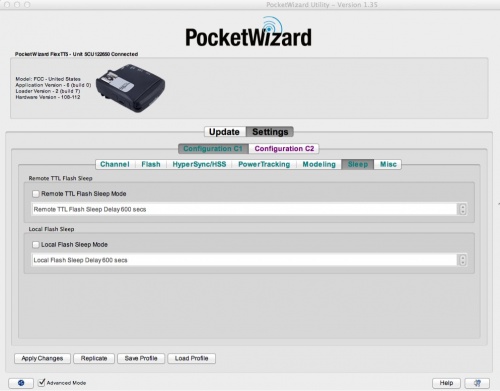Difference between revisions of "Sleep Tab"
(Created page with "'''Remote TTL Flash Sleep Mode''' Normally your ControlTL transmitter tells all remote TTL flashes to sleep when the camera sleeps. This saves batteries in the remote flash but ...") |
(→Remote TTL Flash Sleep Mode) |
||
| (5 intermediate revisions by 3 users not shown) | |||
| Line 1: | Line 1: | ||
| − | + | {{Utility Tab Quick Links}} | |
| − | + | __TOC__ | |
| + | [[File:Sleep.jpg|500px|center|Sleep Tab]] | ||
| − | + | ||
| + | ====Remote TTL Flash Sleep Mode==== | ||
| + | |||
| + | Normally your ControlTL transmitter tells all remote TTL flashes to sleep when the camera sleeps. This saves batteries in the remote flash but could cause the flash to take a moment to be ready before the next trigger. Enable this control to have your ControlTL transmitter wait to tell all remote E-TTL II flashes to sleep until a time after the camera sleeps. This control can be independently over-ridden by a remote flash using Local Flash Sleep Mode. | ||
| + | |||
| + | ====Remote TTL Flash Sleep Delay==== | ||
Sets the number of seconds after the camera sleeps (meters go inactive) when remote TTL flashes will go to sleep. | Sets the number of seconds after the camera sleeps (meters go inactive) when remote TTL flashes will go to sleep. | ||
| − | + | ====Local Flash Sleep Mode==== | |
| + | (FlexTT5 Only) | ||
| + | |||
| + | If you are using a standard transmitter like a Plus or MultiMAX, the sleep command is never sent over the air, and the remote flash mounted on the FlexTT5 would always remain powered on. Enabling this control causes the FlexTT5 connected flash to remain awake for a set period after any radio activity, then enter its sleep mode for power saving. This control overrides Remote TTL Flash Sleep Mode. | ||
| + | |||
| + | |||
| + | |||
| + | |||
| + | |||
| + | ====Modeling Light Sleep Mode==== | ||
| + | (PowerST4 / PowerMC2 Only) | ||
| + | |||
| + | If you are using a standard transmitter like a Plus or MultiMAX, a sleep command is never sent over the air, and the remote flash mounted on the radio would always remain powered on. Enabling this control causes the connected flash to remain awake for a set period after any radio activity, then enter its sleep mode for power saving. | ||
| + | |||
| + | The Modeling Light Sleep Delay setting sets when a locally connected flash will go to sleep after the last incoming radio trigger. | ||
| − | |||
| − | + | ====Hibernate Mode==== | |
| + | (PowerMC2 Only) | ||
| − | + | The Paul C. Buff Einstein E640 is always drawing power when connected to a power source, even when asleep or "Hibernating" - you'll notice the PowerMC2 is operating and blinking even when the Einstein is "Off". The PowerMC2 can Hibernate the Einstein E640 flash after a certain period of inactivity, controlled by the Hibernate Delay setting. This sets the period of time after an incoming trigger that the Einstein will Hibernate. | |
Latest revision as of 13:53, 10 September 2012
| Utility Tab Quick Links |
| Update |
| Channel |
| Flash |
| HyperSync/HSS |
| PowerTracking |
| Modeling |
| Sleep |
| Misc |
| Exposure |
Contents
Remote TTL Flash Sleep Mode
Normally your ControlTL transmitter tells all remote TTL flashes to sleep when the camera sleeps. This saves batteries in the remote flash but could cause the flash to take a moment to be ready before the next trigger. Enable this control to have your ControlTL transmitter wait to tell all remote E-TTL II flashes to sleep until a time after the camera sleeps. This control can be independently over-ridden by a remote flash using Local Flash Sleep Mode.
Remote TTL Flash Sleep Delay
Sets the number of seconds after the camera sleeps (meters go inactive) when remote TTL flashes will go to sleep.
Local Flash Sleep Mode
(FlexTT5 Only)
If you are using a standard transmitter like a Plus or MultiMAX, the sleep command is never sent over the air, and the remote flash mounted on the FlexTT5 would always remain powered on. Enabling this control causes the FlexTT5 connected flash to remain awake for a set period after any radio activity, then enter its sleep mode for power saving. This control overrides Remote TTL Flash Sleep Mode.
Modeling Light Sleep Mode
(PowerST4 / PowerMC2 Only)
If you are using a standard transmitter like a Plus or MultiMAX, a sleep command is never sent over the air, and the remote flash mounted on the radio would always remain powered on. Enabling this control causes the connected flash to remain awake for a set period after any radio activity, then enter its sleep mode for power saving.
The Modeling Light Sleep Delay setting sets when a locally connected flash will go to sleep after the last incoming radio trigger.
Hibernate Mode
(PowerMC2 Only)
The Paul C. Buff Einstein E640 is always drawing power when connected to a power source, even when asleep or "Hibernating" - you'll notice the PowerMC2 is operating and blinking even when the Einstein is "Off". The PowerMC2 can Hibernate the Einstein E640 flash after a certain period of inactivity, controlled by the Hibernate Delay setting. This sets the period of time after an incoming trigger that the Einstein will Hibernate.
